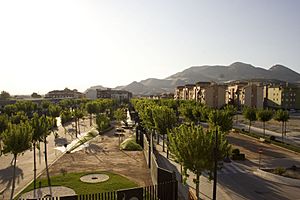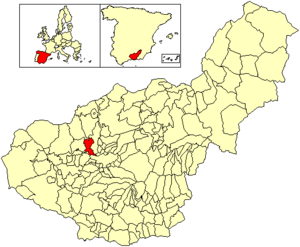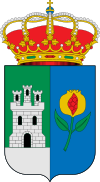Atarfe facts for kids
Quick facts for kids
Atarfe
|
|||
|---|---|---|---|

View of the city showing its Pink Floyd park and surrounding mountains.
|
|||
|
|||
 |
|||
| Country | |||
| Autonomous community | Andalusia | ||
| Province | Granada | ||
| Comarca | Vega de Granada | ||
| Judicial district | Granada | ||
| Area | |||
| • Total | 47 km2 (18 sq mi) | ||
| Elevation | 602 m (1,975 ft) | ||
| Population
(2018)
|
|||
| • Total | 18,554 | ||
| • Density | 395/km2 (1,022/sq mi) | ||
| Demonym(s) | Atarfeño, ña | ||
| Time zone | UTC+1 (CET) | ||
| • Summer (DST) | UTC+2 (CEST) | ||
| Postal code |
18230
|
||
Atarfe is a city in Spain, located in the beautiful region of Andalusia. It's in the province of Granada, close to the city of Granada itself. Rivers like the Cubillas and Colomera flow nearby. Atarfe is surrounded by other towns and has several smaller areas called districts, such as Caparacena and Sierra Elvira.
Contents
A Glimpse into Atarfe's Past
What's in a Name?
The name Atarfe likely comes from an old Arabic word. Some experts think it means "strut," possibly referring to its tall peaks. Others believe it means "limit," because it was once the edge of the ancient city of Elvira.
Early Settlements and Roman Times
People have lived in the Atarfe area for a very long time. The first groups settled here during the Stone Age. Later, the Iberians and Romans also lived here. The Romans founded a city called Ilíberis at the base of Sierra Elvira.
Elvira: A Grand City in Al-Andalus
During the time of the Caliphate, the city was renamed Elvira. It became a very important capital in Al-Andalus, which was the Muslim-ruled part of Spain. Elvira was a major center of culture and power.
Important Battles and Castilian Rule
Many battles took place near Atarfe. One famous fight was the Battle of La Higueruela in 1431. It was fought between the troops of King Juan II and King Muhammed IX of Granada. Another important event was the Battle of the Acequia Gorda in 1486. After these battles, the area became part of the Castilian kingdom. Around 1570, people from Atarfe and nearby towns gathered at the church to become part of Castile.
Exploring Atarfe's Monuments
Church of the Incarnation
The Church of the Incarnation was built in 1501. It stands where an old mosque once was. The church has a beautiful wooden ceiling made by famous artists. Later, more parts were added, like three naves and grand arches. Inside, you can see 12 old paintings from the 1700s.
Santa Ana Hermitage
The Santa Ana hermitage is dedicated to the town's patron saint. It used to be part of a convent. After the convent was no longer used, the chapel became the home of the patron saint, Santa Ana.
Sacred Heart of Jesus Monument
In front of the Santa Ana Chapel, you'll find the Monument to the Sacred Heart of Jesus. This large stone statue was made in 1940 by a local artist named Antonio Cano Correa. The stone used for the monument comes from the nearby Sierra Elvira mountains.
Hermitage of the Three Johns
The Hermitage of the Three Johns was started by a local person who admired three saints named John. It was built in the early 1900s on the ruins of an old castle. The building was finished by the town hall and is now a public viewing point. You can even see exotic animals like peacocks in the surrounding areas.
Celebrations and Local Life
Fun Festivities in Atarfe
Atarfe has exciting local celebrations around July 26th. This day honors Santa Ana, the town's patron saint. During these festivities, there are many cultural and fun activities for everyone. A special event is the bullfights held at the Coliseo Ciudad Atarfe, which is a unique covered bullring.
Tasty Local Foods
Atarfe has some interesting traditional foods. You might try quince jelly or a fresh salad called pipirrana. Other local favorites include "porridge croutons" and a special soup called maimones soup of tata Frasquita.
The 1956 Earthquake
On April 19, 1956, Atarfe and its neighbor Albolote experienced a strong earthquake. It was a magnitude 5.0 earthquake and was the most damaging in Spain during the 20th century. Sadly, twelve people died, and many buildings in the city were destroyed.
Pink Floyd Park
Atarfe is famous for its music concerts. In 2008, Roger Waters, a former member of the legendary band Pink Floyd, performed here. To celebrate this big event, the city council created a public park dedicated to Pink Floyd!
Coliseo de Atarfe: A Hub for Entertainment
The Coliseo de Atarfe is a well-known venue. Many famous music artists have played here, including Placebo, Mark Knopfler, and Leonard Cohen. They perform either inside the Coliseo or outdoors at the Recinto de Feria. The Coliseo also hosts exciting bullfighting events, where top bullfighters like El Fandi, El Cordobes, and Paquirri appear.
See Also
 In Spanish: Atarfe para niños
In Spanish: Atarfe para niños




